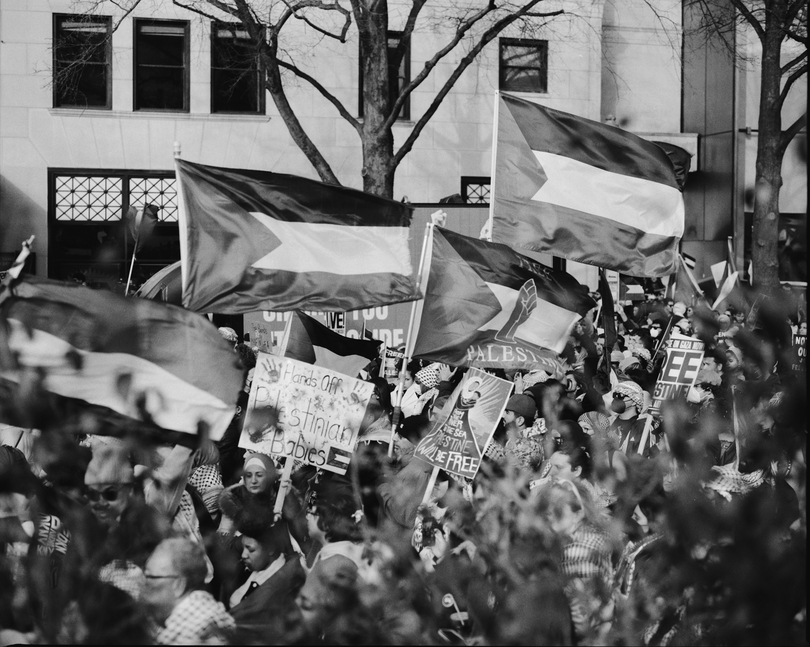March on Washington for Gaza through the eyes of a Palestinian American journalist

Kholood Eid
Photojournalist Kholood Eid describes a protest she documented in January. The protestors gathered in Washington D.C. to call for a ceasefire in Gaza.
Get the latest Syracuse news delivered right to your inbox.
Subscribe to our newsletter here.
Editor’s Note: On March 21, the Newhouse School of Public Communications hosted four journalists for a panel discussion titled “Balanced or biased? Assessing US media coverage of the Israel-Gaza war, and why it matters.” One of the panelists was Palestinian American photographer and filmmaker, Kholood Eid. In January, Eid photographed a march in Washington D.C. of protestors calling for a ceasefire in Gaza. She accompanied them with the opinion piece below.
There were multiple themes pulling me through the crowd of 400,000 people in Washington D.C. Saturday, Jan. 13. Clutching my two film cameras on a jarringly bright, unseasonably warm day with a brisk wind that always managed to sneak up on me throughout the afternoon, I immediately found myself drawn towards children spilling out of Freedom Plaza.
Children showing up to protest the killing of other children, just as I used to do as a young Palestinian American growing up against the backdrop of a violent occupation and shattered ideals, following generations of others who protested before us.

Kholood Eid
Over 10,000 precious young lives lost within four months in a place where the median age is 18.
Irish lawyer Blinne Ni Ghralaigh, who is supporting South Africa’s legal team at the International Court of Justice (and which announced an interim ruling), says the number of orphans caused by “Israel’s genocidal assault on the Palestinian population in Gaza has led to the need for a new acronym: WCNSF—wounded child, no surviving family.”
New language was developed in order to describe the unique level of devastation and destruction this population is enduring. It was impossible for me to separate the profound impact this genocide is having on Palestinian children.
I drove down from New York with my friend and colleague, Stephanie Mei-Ling. We discussed giving each other space to create while still making sure to check back in when needed. This was the first protest I attended since they erupted all over the world after Oct.7.
Everything from symbolism to emotion informed my approach to photographing. The outline of the continent of Africa in a woman’s earring stands out in the crowd and in my mind, as I can’t help but think of South Africa accusing Israel of breaching the United Nations Genocide Convention in its response to Hamas’ Oct. 7 attack, which left roughly 1,200 Israelis dead, at the International Court of Justice in The Hague.
I didn’t know what to expect at the march, which has since been reported as the largest crowd of protestors supporting Palestinians in United States history. Generally, I don’t attend or photograph protests because, as I so often describe to friends and colleagues, “Growing up Palestinian left me protested out.” That and photos in some ways felt too easy or too sensational and I craved more nuance and intimacy with my work.

Kholood Eid
This was different. I knew I had to be present and serve as a witness in whatever way that spoke to me on an internal, even spiritual level. That may be why I found inspiration and beauty in quieter moments like prayer or following light when it inevitably cut through darkness, creating a relationship that existed in the contrast, where the duality of pain and perseverance coexists.
Even the process around the use of film was a deliberate decision meant to, in some ways, heighten my sensibilities through the understanding that, with only so many rolls of film, I had to be intentional with a finite number of frames to capture what this moment felt like for me — even the physicality of using film was cathartic for me. So too were the sounds of Arabic words floating my way and filling me with a mixture of nostalgia, pride and comfort in being among my own community.





